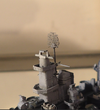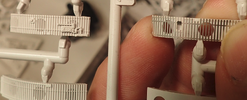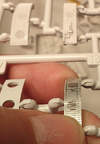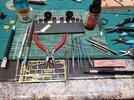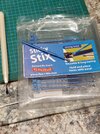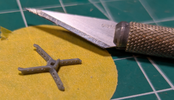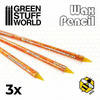AKRoast
New Member
- Joined
- Oct 14, 2024
- Messages
- 29
I would like to ask if most of you are fine with PE parts? I feel like in the few armor and aircraft sets I have done, they were not really needed. They could be close enough with plastic, and the fact that they require CA glue means the chance of messing up is so much greater. I wish kits would always have two methods for the areas they think need PE parts, one using it and one not.
If the PE parts are combined with thin, weak plastic parts that must carry them, then it seems virtually impossible to do neatly.
I am working on a Leopard 2 kit from Tamiya, and it has 2 air filter baskets that hang off the turrent sides. The kit does have good built-in ways to bend the PE pieces, which is better then some kits I have done, but trying to superglue the metal to the thin plastic basket frames proved impossible for me.
I would get one step done (messy) then my fingers would start to stick to the CA and pull things apart.
Meanwhile the multiple trys (both using the CA with the metal to the plastic, and using the plastic cement to put together the plastic parts and trying to attach the plastic frames to the turrent) weakened the plastic frames more and more until it was literally melted into lumps where it needed to attach. The metal basket parts by this point looked like CA splotched crude anyways. I ended up throwing the baskets away before I could damage the otherwise pretty pristine turrent build.
I am trying both thick (but non-gel) Gorilla CA, applied with a toothpick, and very thin CA I got at LHS, which I find just gets everywhere and cannot be applied in small amounts.
I have looked at tutorials on using PE but they just make it seem so easy.
Thanks for any advice
If the PE parts are combined with thin, weak plastic parts that must carry them, then it seems virtually impossible to do neatly.
I am working on a Leopard 2 kit from Tamiya, and it has 2 air filter baskets that hang off the turrent sides. The kit does have good built-in ways to bend the PE pieces, which is better then some kits I have done, but trying to superglue the metal to the thin plastic basket frames proved impossible for me.
I would get one step done (messy) then my fingers would start to stick to the CA and pull things apart.
Meanwhile the multiple trys (both using the CA with the metal to the plastic, and using the plastic cement to put together the plastic parts and trying to attach the plastic frames to the turrent) weakened the plastic frames more and more until it was literally melted into lumps where it needed to attach. The metal basket parts by this point looked like CA splotched crude anyways. I ended up throwing the baskets away before I could damage the otherwise pretty pristine turrent build.
I am trying both thick (but non-gel) Gorilla CA, applied with a toothpick, and very thin CA I got at LHS, which I find just gets everywhere and cannot be applied in small amounts.
I have looked at tutorials on using PE but they just make it seem so easy.
Thanks for any advice

